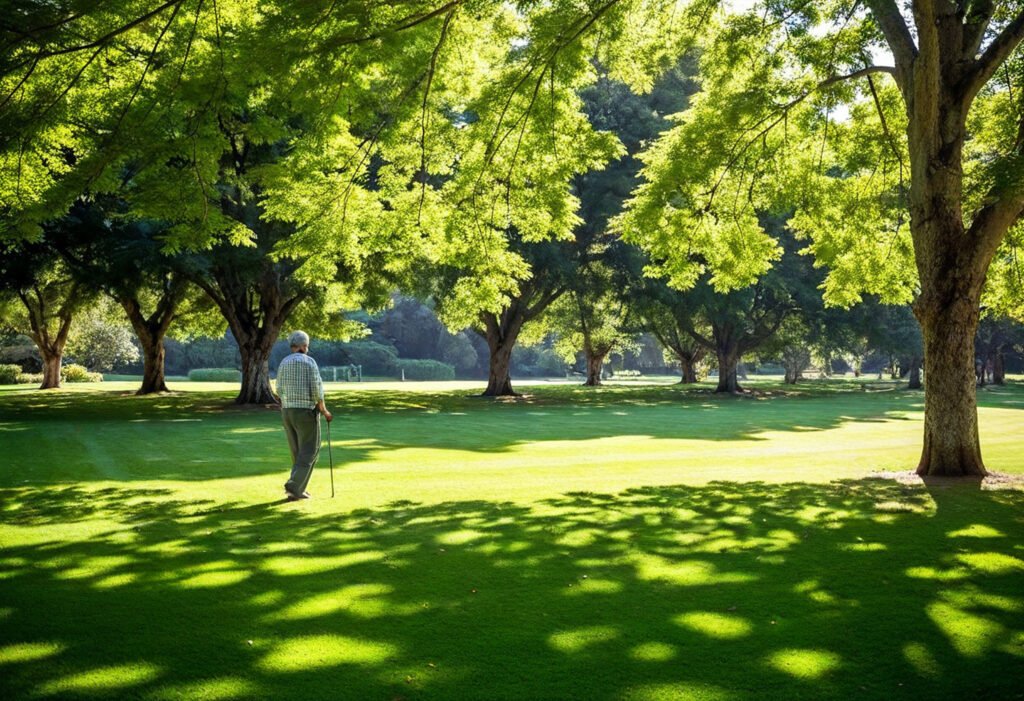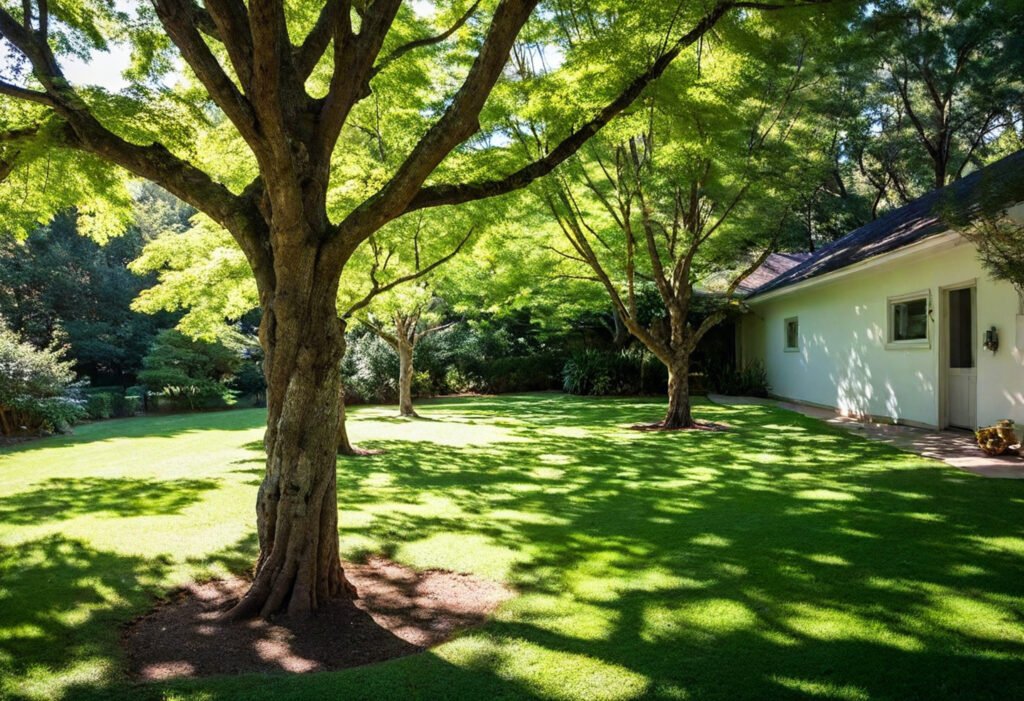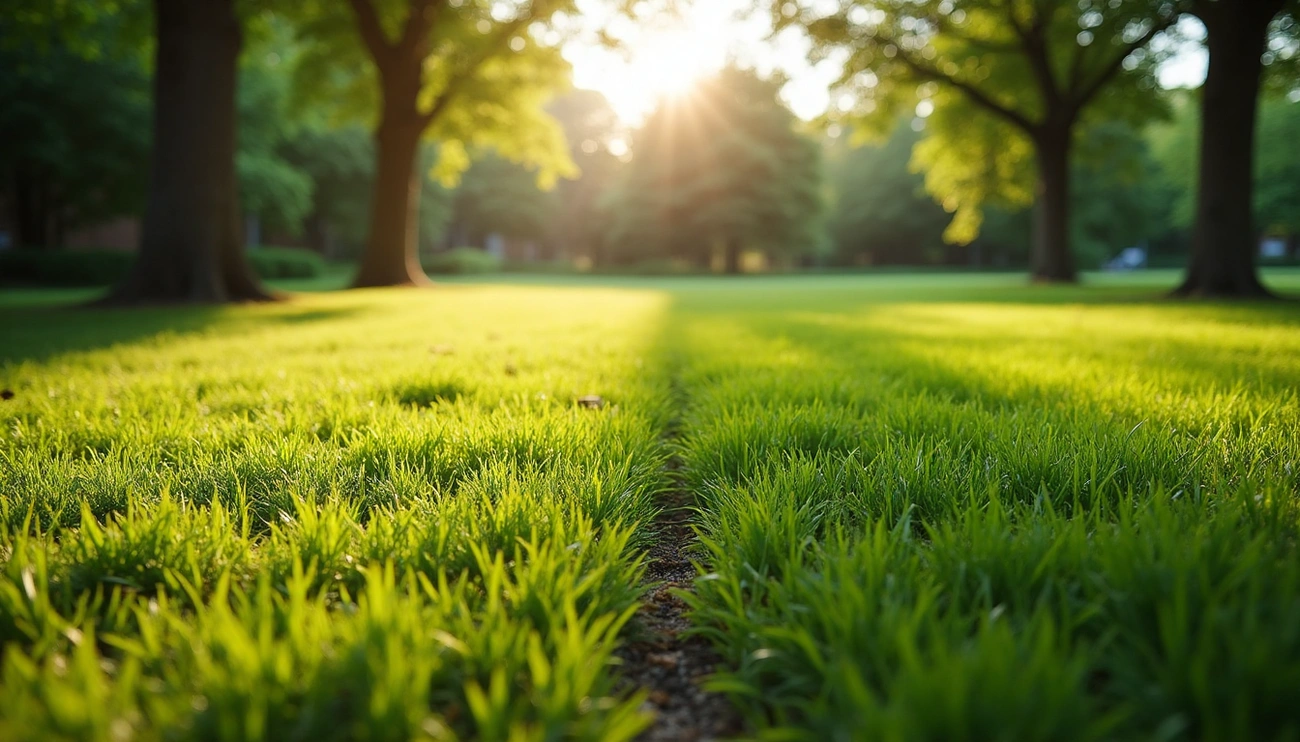Growing grass in shade remains one of the toughest lawn care challenges I’ve faced as a professional gardener. Patchy, thin lawns plague homeowners, especially in shaded spots. The grass stretches toward light and develops weak root systems. Shaded spots can stunt root growth by a lot and leave grass vulnerable to diseases and pests.
My years of testing have helped me find that picking the right grass type makes a difference in shady areas. Kentucky Bluegrass, Perennial Ryegrass, and Fine Fescue thrive as cool-season options with just 4-5 hours of sunlight. St. Augustine and Zoysia excel at growing under trees in warmer climates. The right maintenance makes success possible – yearly aeration and mowing at a 2.5 to 3.5-inch height help maximize photosynthesis. This piece will show you my proven ways to grow healthy grass in shaded spots, even with tough conditions.
Understanding the Challenges of Growing Grass in Shade

The science behind growing grass in shade comes with its own set of problems. Most homeowners think it’s just about not getting enough sun. The truth goes deeper into plant biology and environmental factors.
Why does grass struggle in low light?
Grass faces unique challenges when growing under trees. Light quality changes dramatically in shaded spots. Sunlit areas receive “near red” wavelength light that moves to “far red” in shade, making photosynthesis less effective. Trees with thick canopies, particularly conifers, block the blue part of sunlight that plants need to grow. This filtering stops the turf from making enough carbohydrates, the building blocks plants need to develop.
Tree shade works differently from cloud cover. The uneven mix of blue and red light throws off the plant’s metabolism. One process gets too much stimulation while another barely works. This creates a chain reaction that damages the plant’s natural systems.
Effects of tree roots and poor airflow
Trees and grass fight underground for resources. A big shade tree drinks hundreds of gallons of water daily, leaving the grass thirsty. The battle extends to nutrients, too, which leaves the grass too weak to survive.
Poor air movement creates another serious issue. Sheltered areas don’t let turf:
- Cool down properly
- Dry off quickly after rain
- Get rid of morning dew
- Stay protected from disease
Tree canopies can also block rainfall, putting unexpected drought stress on grass – something people often miss when looking at shade problems.
Common signs of shade stress in lawns
Quick identification of shade stress helps fix problems early. Shaded grass looks different from grass growing in the sun. More shade makes grass produce thinner leaves with weaker protective layers and stems. You’ll see fewer grass shoots and reduced underground growth through rhizomes and stolons.
Plants become softer and more likely to get damaged by weather changes and diseases. The grass grows straight up with longer leaves as it reaches for light. The lawn loses its strength and thins out, letting weeds like ground ivy take over.
These multiple stress factors make maintaining quality turf in shaded conditions tough, but not impossible with proper care.
Best Grass Types for Shaded Areas
The success of growing grass in shade starts with picking the right variety. My years in the field have shown that some grass types do better in low light than others, but their performance really depends on your climate zone.
Cool-season grasses for northern climates
Fine fescues reign supreme in northern shaded lawns and can thrive with just 2-4 hours of direct sunlight each day. These grasses are the foundations of shade-specific seed mixes. Hard fescue shows the best results, with creeping red fescue and chewings fescue right behind it. Tall fescue needs at least 4 hours of sunlight, but its deep roots help it compete with nearby trees. Kentucky bluegrass and perennial ryegrass need 6 hours of sun, so they work best in spots with light shade.
Warm-season grasses for southern regions
St. Augustine grass leads the pack as the South’s most shade-tolerant warm-season grass. You’ll get great results from varieties like Sapphire, Bitter Blue, Palmetto, and Seville with just 4 hours of direct sun. Zoysiagrass comes in second place for shade tolerance. Pine tree shade doesn’t bother centipedegrass and bahiagrass much. Bermudagrass struggles in shady spots, so it’s best to avoid it where light is limited.
Blended seed mixes for transition zones
The transition zones get the best results from special grass blends. A mix of 80% tall fescue and 20% Kentucky bluegrass creates a solid foundation for most partly shaded areas. Areas that don’t get much maintenance do well with 80% tall fescue, 10% Kentucky bluegrass, and 10% fine fescue. These specialty blends usually include multiple varieties of each species. The grass that’s best suited to your yard’s conditions will end up taking over. So, using a mix instead of just one variety gives you a better-looking lawn across areas with different amounts of light.
Step-by-Step Guide to Growing Grass in Shade

Growing lush grass in shaded areas needs a systematic approach to tackle unique challenges. My hands-on experience shows that these six vital steps can help you turn stubborn shaded spots into beautiful lawn areas.
1. Prune trees and reduce dense shade
Light deficiency is your biggest problem. Even shade-tolerant grasses need a minimum of 4 hours of direct sunlight or 6 hours of partial sunlight to grow well. You should prune lower branches to 6-8 feet above ground level and remove them back to the trunk or main leader. The canopy of deciduous trees needs thinning to let sunlight reach your grass. Morning sunlight works best because it dries out grass and helps prevent disease.
2. Aerate the soil for better root growth
Shaded areas usually have compacted soil that drains poorly. Core aeration creates paths for air, water, and nutrients to reach struggling roots. Cool-season grasses need aeration in early fall, at least four weeks before the first frost. Warm-season grasses do better with aeration in late spring or early summer. This step becomes essential under trees where the soil compacts and tree roots compete for resources.
3. Test and amend your soil
Your local extension office can test soil pH and nutrient levels. Shaded lawns often need chemical balance corrections. Test results might show you need to:
- Add lime to raise the pH
- Add sulfur to lower the pH
- Mix in compost to improve structure
- Use appropriate fertilizers at lower rates (shade grasses need about 50% less nitrogen than sun-loving types)
4. Overseed with shade-tolerant varieties
A prepared soil bed needs the right shade-tolerant grass varieties. A drop spreader helps distribute seeds evenly – about 7-10 seeds per square inch. Light raking ensures good seed-to-soil contact. A thin mulch layer keeps moisture in and protects seeds. Fall offers the best time to overseed with its cool temperatures and natural rainfall.
5. Water deeply but infrequently
Proper irrigation makes a huge difference in shaded areas. New seedbeds need light, frequent misting 2-3 times daily for 10-15 minutes until seeds sprout. Then switch to deeper, less frequent watering so roots grow deeper into the soil. This helps grass compete with tree roots for water. Grass under structures needs less water than sunny spots, but grass under trees often needs more water because of root competition.
6. Mow at the right height for shade
Your mower should be at its highest setting for shaded areas—about 3-3.5 inches for most grasses. Taller grass has more leaf surface for photosynthesis and makes up for reduced light. Cut no more than one-third of the blade height each time to avoid stressing the grass. Keep shaded grass about half an inch taller than grass in sunny areas. A sharp mower blade prevents extra stress on your lawn.
Long-Term Maintenance and Common Mistakes to Avoid
A healthy lawn in shaded areas needs special care and maintenance that’s nowhere near similar to sunny lawn care. Your success depends on proper long-term management, even after you’ve planted shade-tolerant grass.
Avoid over-fertilizing shaded lawns
Grass growing in shade needs substantially less fertilizer than grass in full sun. My experience shows that shaded grass only needs half to two-thirds the nitrogen of sun-exposed grass. Your yearly nitrogen application should not exceed 2.0 pounds in shaded areas. Too much fertilizer guides the grass toward weak growth, makes it more prone to diseases, and drains its carbohydrate reserves. The best results come from a single fall fertilization. Slow-release, low-salt fertilizers work best as they provide steady nutrition without pushing excessive growth.
Control weeds without stressing the grass
Thin shaded lawns attract shade-loving weeds like moss, ground ivy, wild violets, and chickweed. Notwithstanding that, harsh chemical treatments often do more harm than good. Hand pulling becomes crucial to stop creeping woodsorrel, nutsedge, dandelion, and spurge from taking over. Spot treatment works better than spreading broad-spectrum herbicides all over your lawn if weeds have already settled in. Note that a thick, healthy lawn naturally keeps weeds away.
Reduce foot traffic in shaded zones
Grass plants under shade stress can’t handle wear from foot traffic well. Mulch or gravel walkways can help direct traffic across your lawn. Areas near play structures or dog runs benefit from recycled rubber playground mulch or a mulch runway along fence lines. Core aeration helps packed soil in high-traffic areas recover.
Time to think over alternatives like ground covers
The time might be right to explore alternatives if recommended practices aren’t helping your shaded grass grow. Here are some options to consider:
- Shade-tolerant ground covers like Common Wintercreeper, Lenten Rose, or Hosta
- Mulched beds with pea gravel, pine needles, or hardwood mulch
- Natural, unmowed areas away from your house
These alternatives create beautiful, low-maintenance spaces that excel where grass struggles to grow.
Conclusion
Growing grass in shade presents unique challenges, but you can achieve success with the right approach. My years as a professional gardener have taught me that understanding the science behind these challenges makes all the difference. Selecting appropriate grass varieties for your shade conditions forms the foundation of long-term success.
The six-step method I’ve outlined goes beyond isolated techniques to create a complete system. Starting with tree pruning and ending at proper mowing height, each step builds on the previous one. This creates ideal conditions for shade-tolerant grasses to thrive even with less light.
Notwithstanding that, you’ll need patience to establish grass in shaded areas. Shaded spots take several growing seasons to reach their full potential, unlike sunny lawns that transform quickly. Your results will improve substantially when you maintain consistent practices tailored to shade conditions.
On top of that, it helps to be realistic about severely shaded areas to save frustration. Some locations just can’t support quality turf, despite our best efforts. Ground covers often work better than fighting an unwinnable battle with grass in these spots.
Note that each shaded lawn comes with its challenges. What works in one yard might need tweaking in another. You’ll develop a customized approach that alters the map of those challenging shaded areas into beautiful, functional spaces by combining these shade-specific strategies with careful observation of your lawn’s response.

